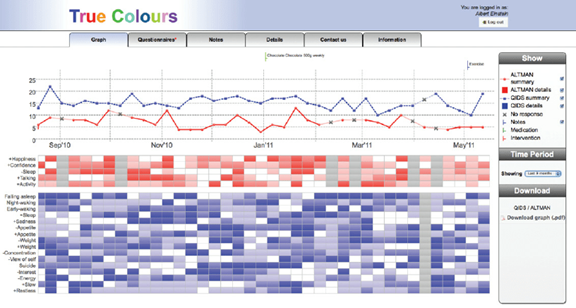We originally published this blog post in September 2019 to highlight the ways in which technology can be used to broaden access to mental healthcare and improve the quality of that care, all the while empowering clinicians to make the best choices alongside their patients.
Since then, the Covid-19 crisis has thrown the importance of improving remote access to mental healthcare into sharp relief.
Mental health staff and social workers may be unable to work due to illness or self-isolation, cutting off a vital support system for patients. Meanwhile, illness, lost work (and the fear of illness and lost work), coupled with lockdown measures which confine people to their homes and cut them off from their friends and family have all led to a rise in the severity of mental health symptoms across the board. Indeed, Research by the University of Sheffield and Ulster University observed a spike in depression anxiety one day after lockdown measures were put in place. Young people, with health conditions, with lower incomes or whose incomes had been hit by the pandemic, reported higher rates of anxiety and depression.
Now more than ever there is impetus to improve access to mental healthcare. Peer to Peer support, automated triage and patient self reporting can all be used to save clinician time and empower patients.

How technology can make mental health care work better
One in four people will experience mental illness each year, with many of those not necessarily receiving treatment for their illness. According to a recent survey, 6 in 10 people with bipolar disorder are not in receipt of any treatment, and nor are nearly 1 in 5 with a psychotic disorder such as schizophrenia. There are many reasons for this treatment gap but one is long NHS waiting times and difficulty accessing treatment. Funding pressures have made the situation worse; a late 2018 report found that 4 out of 5 NHS funding directors reported that funding pressures led to increased waiting times for those in need of mental health treatment.
This doesn’t mean replacing healthcare professionals - digital solutions can help them to help even more patients. Software excels in certain areas such as:
- Broadening access to care and helping to reach more patients
- Automating triage and other kinds of admin
- Enabling patient self reporting and tracking
- Giving us access to new diagnosis tools
While letting clinicians focus on high value tasks such as delivering therapy.
In this article we look at some of the ways in which technology can work together with clinicians to deliver better care.
Broadening access to care
Unfortunately, stigma surrounding mental health can prevent individuals reaching out for treatment, and some groups experience more stigma than others such as men and people in the military. Technology can offer a route around that stigma. Research shows that many patients feel more comfortable sharing mental health symptoms with a chatbot than with a human. A trial of SUbot, a therapy chatobot desgined to address male depression and suicide showed that patients were five times more likely to share their real feelings with an unmonitored machine than with a human.
Stigma is not the only barrier to accessing care. Other barriers include long waiting lists and geography, with treatment particularly difficult to access in rural areas. This is what start-up Ieso aims to tackle with its online therapy offering. Ieso is available on the NHS and employs human therapists to provide text-based cognitive behavioral therapy for 15,000 patients a year. “A third of our patients are from rural areas. People don’t have to travel, they can continue to work, but have improved access to therapy,” said Nigel Pitchford, chief executive of Ieso in an interview with the Financial Times.
Peer to Peer Support
Kin + Carta recently worked with XenZone, who use technology to create new ways for people to access mental healthcare, regardless of location. Kooth is the leading mental health platform in the UK, giving young people access to counsellors online with the benefit of anonymity. Kin + Carta explored ways to develop Kooth’s peer-to-peer community, in order to promote improved emotional wellbeing and mental health outcomes for its users, allowing them to better support one another in addition to receiving individual counselling sessions. As well as conducting research in schools with young people, Kin + Carta collaborated with XenZone counselors and clinicians to produce an innovative and clinically safe peer-to-peer concept. The product is currently undergoing evaluation with a leading London university.
The Covid-19 crisis has thrown the importance of improving remote access to mental healthcare into sharp relief.
See how it has affected other servicesAutomating triage and reducing admin
The NHS has long waiting lists, and a shortage of clinicians available to administer therapy. Technology could help automate some of the lower-level tasks such as triage to free up clinician time to deal with higher-level tasks (such as therapy). The NHS has begun trials using its own chatbot called MhtBot (Mental Health Triage Bot) to help GPs and mental health professionals triage patients effectively. Ordinarily, patients would be triaged using paper-based questionnaires at their GP. This means that the patient has to go to the GP to take the questionnaire and it must be administered, marked and sorted by a clinician. Instead, a patient can talk to MhtBot at home. This not only saves time, but has the added benefit of being outside the clinical setting so users are more comfortable being honest about symptoms. The programmers estimate that for every instance of triage, MhtBot will save two hours of patient time and one hour of clinician time.
Enabling patient self-reporting
Managing a mental health condition isn’t simply about medication and therapy; monitoring tools can be effective in helping patients understand and take control of their condition, as well as offer data points to discuss with clinicians. True Colours was developed by Oxford University to help bipolar patients self- monitor their symptoms whether manic or depressive. Patients are invited to report their systems several times a week via text, email or web. This data is input into the True Colours website, and patients are able to look back on the data in graph form to view how they have been progressing. They can also use the data to discuss their symptoms with their clinician, which removes the risk of recall bias.

Meanwhile, Greater Manchester Mental Health Foundation Trust has begun using an app called ClinTouch with Serious Mental Illness patients. Serious Mental Illness (SMI) is typically defined as mental illnesses which involves psychosis or requires a high level of care, such as schizophrenia or bipolar disorder. Patients will generally see a clinician monthly, but relapse symptoms can appear within days. ClinTouch sends multiple prompts a day for patients to rate and comment on their symptoms. If a relapse seems likely, then their clinician can intervene. University of Manchester professor of adult psychiatry Schôn Lewis notes that around half of all patients find it useful, while some even suggest additional functionality, such as medication reminders.
New diagnosis tools based on digital data points
Diagnosing mental health conditions relies largely on the self reporting of symptoms. Whereas physical conditions are diagnosed with biomarkers such as low levels of iron or insulin, with mental health conditions there are typically no such objective data points. There is potential to change this however with a new approach based on digital data; observing how users swipe mobile phones, the content of their social media posts, the timbre of their voices when they make a call. This approach is known as digital phenotyping. Thomas R. Insel writing in the World Psychiatry journal writes, “Subtle aspects of typing and scrolling, such as the latency between space and character or the interval between scroll and click, are surprisingly good surrogates for cognitive traits and affective states.” The promise of digital phenotyping is that patients and clinicians will no longer have to rely on self- reported symptoms; they can track their condition accurately.
However, digital phenotyping is a controversial approach; in its purest form it offers little privacy to the patient. For schizophrenic patients, the monitoring of digital devices can exacerbate the feeling of being watched and trigger paranoia.